#DynamicPricingAlgorithms
Explore tagged Tumblr posts
Text
How Travel Sites Push Monsoon Deals: MMT, Yatra & Agoda Trends
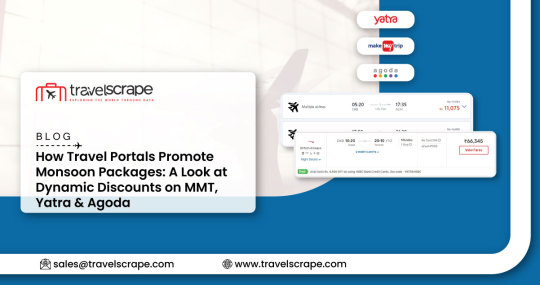
Powered by Travel Scrape
Monsoon season, with its lush landscapes and cooling rains, is a golden opportunity for travel companies to entice consumers with attractive getaway packages. But behind the scenic images and tempting headlines lies a powerful force: dynamic pricing algorithms. Travel portals like MakeMyTrip (MMT), Yatra, and Agoda use advanced pricing strategies to promote monsoon deals based on real-time data inputs like weather, occupancy, demand, and competitor rates.
In this blog, we dive into how monsoon travel packages evolve week by week across these platforms, using scraped data analyzed by Travel Scrape. The results reveal not only how discounts shift, but also how travel portals manipulate inventory, offer types, and urgency messages to push conversions.
Why Monsoon Packages Are Perfect for Dynamic Discounting
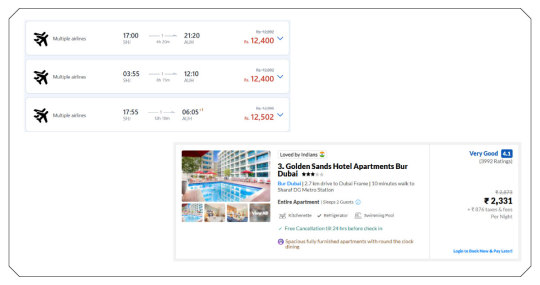
The monsoon period (June–September in India and Southeast Asia) is considered shoulder season for many destinations. It's a time when hotel occupancies dip, airfares soften, and travel brands compete for a smaller yet highly engaged segment of leisure travelers.
Key triggers for dynamic pricing during monsoon:
Rain forecasts: Real-time weather APIs influence resort pricing, especially in destinations like Goa, Kerala, and the Western Ghats.
Flash floods and alerts: In areas affected by monsoon-related hazards, dynamic pricing responds by offering deeper discounts or blackout dates.
Flight fare fluctuations: Travel portals adjust hotel + flight packages based on airline fare volatility.
Search trends: Spikes in destination searches lead to temporary price increases.
Room inventory pressures: As fewer people travel, unsold room nights become more aggressively discounted.
Methodology: Scraping Weekly Package Data from Top Portals
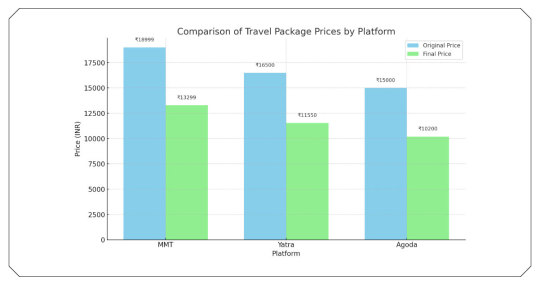
Travel Scrape monitored 200+ monsoon travel packages across MMT, Yatra, and Agoda between June 1 and July 1, 2025, focusing on popular destinations like:
Goa
Munnar
Shillong
Lonavala
Udaipur
Each week, the system captured:
Package name
Discount %
Original and final price
Stay duration
Date of validity
Inclusions (meals, airport transfers, etc.)
Urgency cues (e.g., “Only 2 rooms left!”)
Sample Scraped Dataset (Goa - Week 1)

Weekly Evolution of Discounts (MMT, Yatra, Agoda)
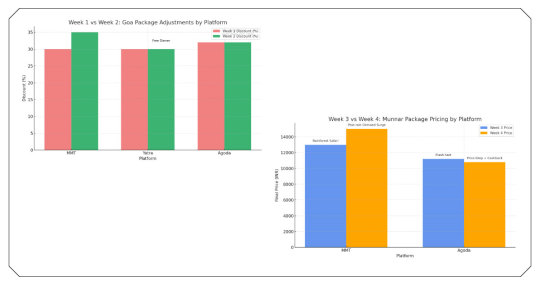
Week 1 vs Week 2 (Goa)
MMT: Increased discount from 30% → 35%
Reason: Heavy rainfall alert led to lower bookings
Yatra: Introduced free dinner add-on instead of deeper discount
Agoda: Dropped price by ₹500 but added "Book Now, Pay Later" option
Week 3 vs Week 4 (Munnar)

Dynamic Discounting Tactics by Platform
MakeMyTrip (MMT)
Adaptive Banner Messaging: “Monsoon Flash Sale – Up to 40% Off Today Only”
Countdown Timers: Visibly ticking clocks on package pages
Urgency Nudges: “2 rooms left at this price!”
Loyalty Discounts: Extra 10% for MMT Black users
Dynamic Add-Ons: Free meals or activities if booking during rain alerts
Yatra
Flexible Cancellation Hooks: Prominent messaging for worry-free bookings
Targeted Email Blasts: Personalized monsoon packages based on user history
Combo Deals: Clubbed with bus/flight deals; prices change daily
Real-Time Price Comparison Widget: Displays rate drops since last visit
Agoda
AI-Powered Recommendations: Based on browsing and click behavior
Gamified Discounts: “Spin to Win” during monsoon promo weeks
Localized Currency Fluctuation Offers: Leverages FX drops for extra discounts
Late Check-Out Promos: Popular in rainy hill stations
Monsoon Pricing Trends: Key Insights from Our Data

1. Average Discount Deepens Mid-Monsoon
Between June 1–10, average package discounts were 26–30%. By June 21–30, discounts had reached 32–38%.
2. Hill Stations Offer Higher Percentage Discounts
Goa packages averaged a 28% discount.
Munnar and Shillong averaged up to 35% in late June.
3. Dynamic Inclusions Drive Perceived Value
Rather than lowering price outright, platforms added:
Candlelight dinners
Nature trail experiences
Ayurvedic spa sessions
4. Surge Pricing Resurfaces on Weekends
Despite monsoon season, Saturday check-ins showed price spikes of 8–15% on all platforms due to weekend demand.
Sample Comparison: Shillong Packages (July 1 Snapshot)
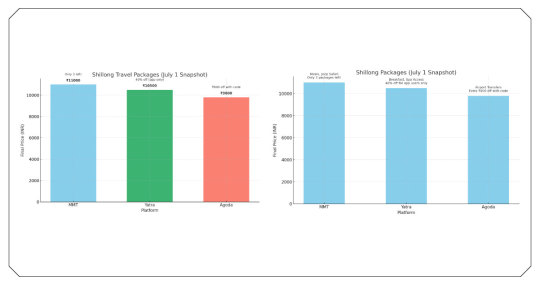

How Travel Scrape Enables This Tracking
At Travel Scrape, we build AI-driven tools to extract, clean, and analyze travel data at scale. Our monsoon discount tracking engine pulls:
Daily snapshots of package listings
Historical price timelines
Inclusion add-ons and urgency indicators
Geo-specific promo trends
Use Cases:
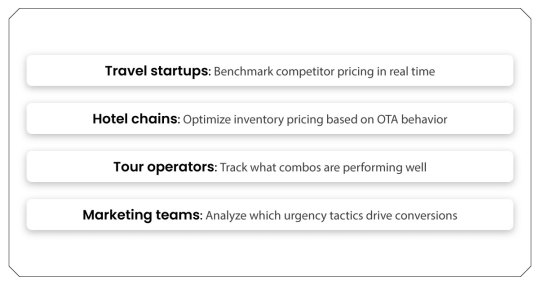
Travel startups: Benchmark competitor pricing in real time
Hotel chains: Optimize inventory pricing based on OTA behavior
Tour operators: Track what combos are performing well
Marketing teams: Analyze which urgency tactics drive conversions
If you're a travel business looking to monitor competitor deals, analyze dynamic pricing, or understand what drives OTA promotions during monsoon and beyond — our tools deliver structured, actionable intelligence.
Conclusion: What Travel Brands Can Learn
The monsoon season is a goldmine of dynamic pricing experimentation. MMT, Yatra, and Agoda actively tweak packages week by week, using a blend of discounts, value-adds, and urgency cues to capture short-term demand.
The winners? Brands that adapt fast, personalize deals, and use data to inform offers. With scraping tools from Travel Scrape, your travel business can stay ahead of OTA pricing trends — not just during monsoon, but all year round.
Source : https://www.travelscrape.com/mmt-yatra-agoda-monsoon-travel-deals.php
#DynamicPricingAlgorithms#MonsoonTravelPackages#MonsoonPricingTrends#TravelPortalsPushMonsoonDeals#MMTTrends#YatraTrends#AgodaTrends
0 notes
Text
Decoding the Algorithm: How Online Platforms Determine Flight Ticket Prices
In an era where technology has transformed the way we travel, booking flight tickets has become a digital endeavor. Gone are the days of visiting travel agencies or calling airlines directly to secure your seat on a plane. Today, with just a few clicks or taps, travelers can compare prices, select their preferred seats, and complete their bookings entirely online. However, behind the convenience of online ticket booking lies a complex web of algorithms that determine the prices displayed to consumers. Understanding how these algorithms work can empower travelers to make more informed decisions and potentially save money on their next trip.
Book cheap flight tickets and hotels- https://cheaptravelfirst.com/
The Rise of Online Travel Platforms
The shift towards online ticket booking can be attributed to the proliferation of online travel platforms. These platforms act as intermediaries between airlines and travelers, providing a convenient marketplace where flights from various carriers are aggregated and displayed in one place. Examples of such platforms include Expedia, Booking.com, Kayak, and Google Flights, among others. These platforms have revolutionized the way people plan their trips, offering unprecedented access to information and options.
Dynamic Pricing: The Backbone of Ticket Pricing Algorithms
At the heart of online ticket pricing algorithms is the concept of dynamic pricing. Unlike traditional fixed pricing models, where ticket prices remain constant until the flight's departure, dynamic pricing algorithms continuously adjust fares based on various factors such as demand, time until departure, competitor pricing, and even the user's browsing history.
Factors Influencing Ticket Prices
Demand: One of the most significant factors influencing ticket prices is demand. During peak travel seasons or for popular destinations, prices tend to be higher due to increased demand. Conversely, off-peak times may offer lower fares as airlines try to fill empty seats.
Time Until Departure: As the departure date approaches, airlines may adjust prices based on remaining seat availability. Early bookings often come with discounted fares, while last-minute bookings may incur higher costs.
Competitor Pricing: Airlines closely monitor their competitors' pricing strategies and may adjust their own fares accordingly. If a competing airline lowers its prices for a particular route, others may follow suit to remain competitive.
Browsing History and Cookies: Online travel platforms use cookies to track users' browsing history and behavior. If a user repeatedly searches for a specific route or shows a high level of interest in a particular flight, the platform may display higher prices to create a sense of urgency or scarcity.
Seasonality and Events: Special events, holidays, and seasonal trends can also impact ticket prices. For example, flights to popular tourist destinations may be more expensive during peak vacation periods.
The Role of Machine Learning and Big Data
To effectively implement dynamic pricing, online travel platforms rely on advanced technologies such as machine learning and big data analytics. These platforms analyze vast amounts of historical and real-time data to predict future demand patterns and optimize pricing strategies accordingly. Machine learning algorithms can identify trends, correlations, and anomalies in data that human analysts may overlook, allowing for more accurate pricing decisions.
Ethical Considerations and Transparency
While dynamic pricing algorithms can benefit both airlines and consumers by optimizing revenue and offering competitive fares, they also raise ethical concerns regarding fairness and transparency. Some argue that the opacity of pricing algorithms can lead to price discrimination, where certain groups of travelers are charged higher prices based on factors such as their location or browsing history. Additionally, the lack of transparency regarding how prices are determined can erode trust between consumers and online travel platforms.
Conclusion
Deciphering the algorithms behind flight ticket pricing is no easy task, but understanding the key factors and technologies involved can help travelers navigate the complex world of online booking. By staying informed about dynamic pricing strategies and leveraging tools such as fare trackers and incognito browsing, travelers can increase their chances of finding the best deals for their next journey.
#FlightTicketPricing#DynamicPricingAlgorithm#OnlineTravelPlatforms#MachineLearning#BigDataAnalytics#TravelTechnology#PriceOptimization#DynamicPricingFactors
0 notes
Text
Decoding the Algorithm: How Online Platforms Determine Flight Ticket Prices
In an era where technology has transformed the way we travel, booking flight tickets has become a digital endeavor. Gone are the days of visiting travel agencies or calling airlines directly to secure your seat on a plane. Today, with just a few clicks or taps, travelers can compare prices, select their preferred seats, and complete their bookings entirely online. However, behind the convenience of online ticket booking lies a complex web of algorithms that determine the prices displayed to consumers. Understanding how these algorithms work can empower travelers to make more informed decisions and potentially save money on their next trip.
For more features please visit https://trailtravelz.com/
The Rise of Online Travel Platforms
The shift towards online ticket booking can be attributed to the proliferation of online travel platforms. These platforms act as intermediaries between airlines and travelers, providing a convenient marketplace where flights from various carriers are aggregated and displayed in one place. Examples of such platforms include Expedia, Booking.com, Kayak, and Google Flights, among others. These platforms have revolutionized the way people plan their trips, offering unprecedented access to information and options.
Dynamic Pricing: The Backbone of Ticket Pricing Algorithms
At the heart of online ticket pricing algorithms is the concept of dynamic pricing. Unlike traditional fixed pricing models, where ticket prices remain constant until the flight's departure, dynamic pricing algorithms continuously adjust fares based on various factors such as demand, time until departure, competitor pricing, and even the user's browsing history.
Factors Influencing Ticket Prices
Demand: One of the most significant factors influencing ticket prices is demand. During peak travel seasons or for popular destinations, prices tend to be higher due to increased demand. Conversely, off-peak times may offer lower fares as airlines try to fill empty seats.
Time Until Departure: As the departure date approaches, airlines may adjust prices based on remaining seat availability. Early bookings often come with discounted fares, while last-minute bookings may incur higher costs.
Competitor Pricing: Airlines closely monitor their competitors' pricing strategies and may adjust their own fares accordingly. If a competing airline lowers its prices for a particular route, others may follow suit to remain competitive.
Browsing History and Cookies: Online travel platforms use cookies to track users' browsing history and behavior. If a user repeatedly searches for a specific route or shows a high level of interest in a particular flight, the platform may display higher prices to create a sense of urgency or scarcity.
Seasonality and Events: Special events, holidays, and seasonal trends can also impact ticket prices. For example, flights to popular tourist destinations may be more expensive during peak vacation periods.
The Role of Machine Learning and Big Data
To effectively implement dynamic pricing, online travel platforms rely on advanced technologies such as machine learning and big data analytics. These platforms analyze vast amounts of historical and real-time data to predict future demand patterns and optimize pricing strategies accordingly. Machine learning algorithms can identify trends, correlations, and anomalies in data that human analysts may overlook, allowing for more accurate pricing decisions.
Ethical Considerations and Transparency
While dynamic pricing algorithms can benefit both airlines and consumers by optimizing revenue and offering competitive fares, they also raise ethical concerns regarding fairness and transparency. Some argue that the opacity of pricing algorithms can lead to price discrimination, where certain groups of travelers are charged higher prices based on factors such as their location or browsing history. Additionally, the lack of transparency regarding how prices are determined can erode trust between consumers and online travel platforms.
Conclusion
Deciphering the algorithms behind flight ticket pricing is no easy task, but understanding the key factors and technologies involved can help travelers navigate the complex world of online booking. By staying informed about dynamic pricing strategies and leveraging tools such as fare trackers and incognito browsing, travelers can increase their chances of finding the best deals for their next journey.
#FlightTicketPricing#DynamicPricingAlgorithm#OnlineTravelPlatforms#MachineLearning#BigDataAnalytics#TravelTechnology#PriceOptimization#DynamicPricingFactors#EthicalPricing#TransparentPricing
0 notes
Text
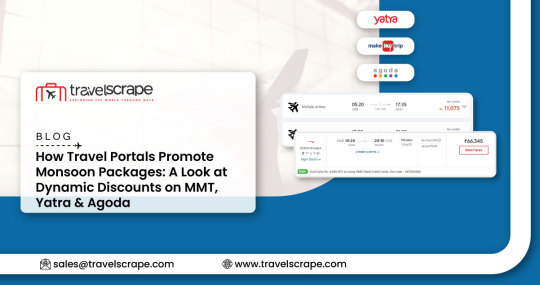
How Travel Sites Push Monsoon Deals: MMT, Yatra & Agoda Trends
Explore real weekly data to see how MMT, Yatra & Agoda adjust monsoon travel deals dynamically. Insights powered by Travel Data Scrape.
#DynamicPricingAlgorithms#MonsoonTravelPackages#MonsoonPricingTrends#TravelPortalsPushMonsoonDeals#MMTTrends#YatraTrends#AgodaTrends
0 notes
Text
How Travel Sites Push Monsoon Deals: MMT, Yatra & Agoda Trends
Explore real weekly data to see how MMT, Yatra & Agoda adjust monsoon travel deals dynamically. Insights powered by Travel Data Scrape.
#DynamicPricingAlgorithms#MonsoonTravelPackages#MonsoonPricingTrends#TravelPortalsPushMonsoonDeals#MMTTrends#YatraTrends#AgodaTrends
0 notes